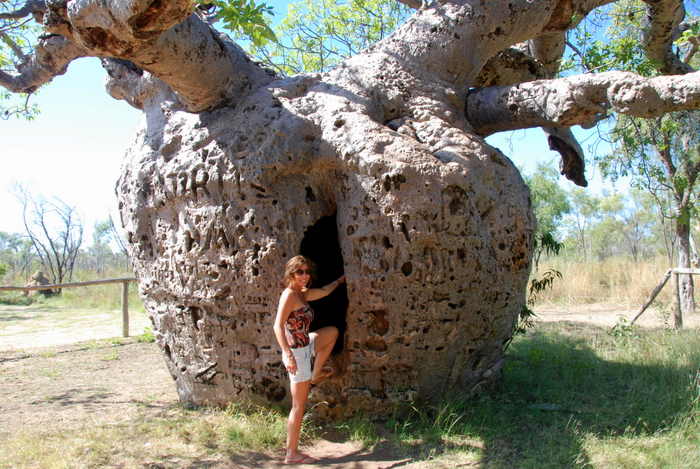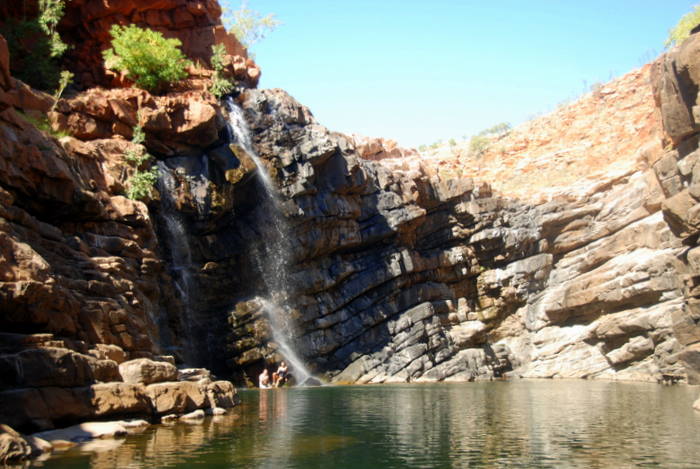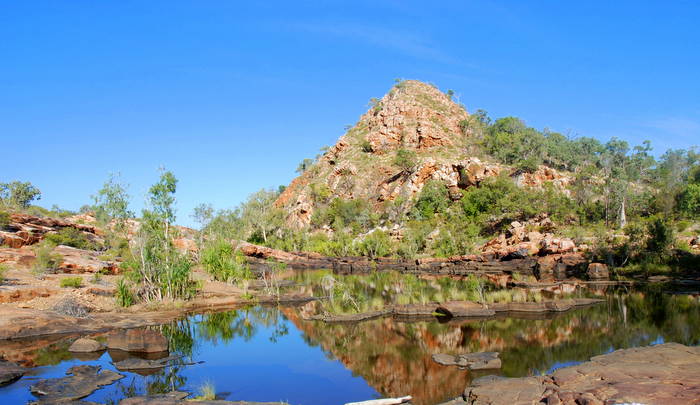Day 11 Broome to Windjana
- The western portion of the Gibb River Road
We stocked the fridges before we left Broome for our adventure along the Gibb River Road.
- Tammy was fascinated by the Australian name of what she called ‘shopping carts’.
The Great Northern Highway leads east out of Broome 160+ kilometres to the Willare Bridge Roadhouse, a kilometre past the mighty Fitzroy River.
- Termite mounds, up to three metres high, are a defining feature of the northern Australian landscape. The spinifex termite builds large globular mounds common around Broome.
- Termite mounds.
- Minnie River.
- Minnie Bridge over the Minnie River, an anabranch of the Fitzroy.
- Willare Bridge over the Fitzroy River.
- Fitzroy River at Willare, 2010.
- The bric a brac at the Willard Bridge Roadhouse is typical of many outback roadhouses and pubs.
- Directory
- Triple road train – 53.5 metres in length (for those working in Freedom Units that is 15 feet longer than the width of a US football field). Carries up to 220 tonnes at 100 km/h. 62 wheels (2 steer, 8 drive and 52 trailer). They operate only in the Australian Outback.
- Raptor
We refuelled at the Roadhouse and headed north. The road continues straight to Derby and it is actually Great Northern Highway (Highway 1) that deviates to the east.
- We continued straight ahead.
We took the road towards Derby. The Gibb River Road starts just outside Derby.
- Boab Prison Tree.
- Just released.
- Rarely closed at the time of year when we travelled.
- We did them all except Geikie Gorge which is accessed via Highway 1.
- Termite mound.
- Start of the Gibb River Road.
- On the Gibb.
Windjana Gorge is an iconic destination along the Gibb River Road.
- Napier Range, in which the Windjana Gorge has been formed by the Lennard River.
After we set up camp it was time for a walk up the Gorge. The track extends for 3.5 kilometres following the bed of the Lennard River through the Napier Range but as it was late in the afternoon we chose not to do the full distance.
- Start of the Gorge Walk.
- leading up the Lennard River.
- Along the Gorge Walk.
- in Windjana.
- Along the Gorge Walk.
- Johnston Crocodile.
- Crocodylus Johnstoni
- Lizards.
- Fish eaters.
- Harmless to humans – except when they bite.
- Battlements of Windjana.
- Johnston crocodile.
- Black Flying Foxes or Black Fruit Bats (Pteropus alecto).
- Native to Australia, Papua New Guinea and Indonesia.
- Colonies of the bats can number tens of thousands.
- They are not a threatened species.
- May be a disease vector.
- Black Flying Fox or Black Fruit Bat (Pteropus alecto).
- Return to camp.
- So much clearer in The Outback.
Day 12 Windjana to Silent Grove
Leaving Windjana we took a 33 kilometre detour south to Tunnel Creek. Dusty conditions, unfenced road and wandering cattle equals hazardous driving.
- Brahmin cattle.
- Lots of dust
- Lots of cattle
- Beasts weighing close to two tonne appear out of the dust and wander across the track.
Tunnel Creek is a 750 metre long underground passage carved out of the limestone of Napier Range by flowing water. The creek once flowed across the top of the Range but water seepage gradually enlarged fractures in the limestone until it reached today’s underground course. The Tunnel is up to 12 metres high and 15 metres wide and contains permanent pools of fresh water in which freshwater crocodiles are found.
In the late 19th century, it was a hideout for the aboriginal Jandamurra while evading Police for crimes of murder and robbery. In earlier times the tunnel was known as the Cave of Bats, as at least five species of bat are known to inhabit it.
- It gets dark fairly quickly.
Tammy was way, way out of her comfort zone. To her credit she made it all the way to end of the cave.
The bats did nothing to alleviate her fears.
I didn’t tell her about the resident crocodiles until after we had returned to the entrance.
- The end of the tunnel is in sight
- From this point there is no option but to return back through the tunnel
Tammy’s realisation that she would have to make a second journey through the Tunnel was a real challenge for her. Brave girl. She kept her cool, conquered her fears and after she climbed back out to daylight was able to celebrate a personal victory.
- Just as scary
- on the return.
The road back to the Gibb was in terrible condition, corrugated, pot holed and dusty.
- Napier Range is part of an
- ancient limestone Devonian reef system
- south of and parallel to
- the King Leopold Range.
- Oncoming Oka. The Oka was an Australian manufactured 4WD.
We turned back onto the Gibb River Road, heading towards our planned overnight stop at Silent Grove. A few kilometres to the north-east we passed what is colloquially known as Queen Victoria’s Head.
- This pass through the Napier Range is officially known as Yammera Gap but for obvious reasons one can see why its unofficial name is Queen Victoria’s Head.
- Typical rangelands along the western part of the Gibb. View from the Lookout at Stumpys Jumpup.
Our next stop, Lennard Gorge, is a few kilometres past Inglis Gap. Lennard Gorge is a spectacular waterfall and swimming hole formed by the Lennard River as its cuts its way through the King Leopold Range. The track into the gorge is rough and the path from the carpark to the waterhole is indistinct.
- Still waters of the Lennard River.
- The Lennard River crosses the Gibb River Road.
- Intervention by the Park Managers means that visitors now have walk a kilometre or so to the gorge instead of driving to the immediate vicinity.
- On the track into Lennard Gorge.
- To Lennard Gorge.
- Dragonfly
- The swimming hole at Lennard Gorge.
- Lennard Gorge swimming hole.
- Kim at swimming hole.
- Kim and Tammy at Lennard Gorge.
- Water Monitor.
- Leaving Lennard Gorge.
- Unnamed peak in the King Leopold Range on the drive into Lennard Gorge.
- Lennard River.
- On the Gibb River Road.
- Rangelands
- Rangelands
- Rangelands
- On the Gibb River Road.
- Bell Creek
The campsite at Silent Grove was nearly full. The resident Monitor lizard was fed by everyone.
- Monitor
Silent Grove is the campground for Bell Gorge, the most popular gorge and waterfall along the Gibb.
- On the walk track into Bell Gorge.
- Track into Bell Gorge.
- Bell Creek
- Pool above the waterfall on Bell Creek.
- The waterfall at Bell Gorge.
- Waterfall at Bell Gorge.
- Waterfall at Bell Gorge.
- At Bell Creek.
- Bell Gorge



























































































































